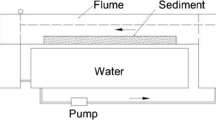Abstract
Freshwater clams (Anodonta cygnea) were exposed to cadmium under laboratory conditions. Time courses of Cd accumulation were determined for whole animal and the separate organs. At 5 Μg/L, Cd accumulation proceeded mainly linearly. At 25 Μg/L, the accumulation pattern was biphasic for whole animals and most of the organs: during the first four weeks Cd concentrations increased linearly, remaining at a constant level for the next two weeks. Thereafter, metal concentrations increased strongly until, after 10 weeks, a saturation level was reached. It is argued that the biphasic course of accumulation is not caused by an advancing selection through mortality or by the gradually decreasing mean animal weight, nor by the typical laboratory conditions of absence of food and substratum. The partition of total Cd among the organs gradually changed over the first eight weeks, remaining constant from that time. The ultimate order of Cd concentrations was: gills > labial palps > mantle-edge > mantle, kidney, whole animal > midgut gland > guts/gonads complex > foot. A possible relation between the time course of Cd accumulation and behavioral responses is presented.
Similar content being viewed by others
References
Anderson RV (1977) Concentration of cadmium, copper, lead, and zinc in six species of freshwater clams. Bull Environ Contam Toxicol 18:492–496
ARW (1982) Annual report (in German). Arbeitsgemeinschaft Rhein-Wasserwerke e.V., Karlsruhe
V.-Balogh K, Salánki J (1984) The dynamics of mercury and cadmium uptake into different organs ofAnodonta cygnea L. Water Res 18:1381–1387
Caperna TJ, Failla ML (1984) Cadmium metabolism by rat liver endothelial and Kupffer cells. Biochem J 221:631–636.
Carter AP, Felber BK, Walling M, Jabier MF, Schmidt CJ, Hamer DH (1984) Duplicated heavy metal control sequences of the metallothionein-I gene. Proc Natl Acad Sci USA 81:7392–7396
Coombs TL (1979) Cadmium in aquatic organisms. In: Webb M (ed) The chemistry, biochemistry and biology of cadmium. Elsevier, Amsterdam, pp 93–141
Duinker JC, Kramer CJM (1977) An experimental study on the speciation of dissolved zinc, cadmium, lead and copper in river Rhine and North sea water, by differential pulsed anodic stripping voltametry. Mar Chem 5:207–228
Forester A (1981) Unionacean molluscs (mussels, clams, naiads) as biological indicator of toxic metals in the freshwater ecosystem. In Proc of the International Conference: Heavy metals in the Environment. Amsterdam—September 1981. CEP Consultants Ltd, Edinburgh, p 404
Graney Jr. RL, Cherry DS, Cairns Jr J (1984) The influence of substrate, pH, diet and temperature upon cadmium accumulation in the Asiatic clam (Corbicula fluminea) in laboratory artificial streams. Water Res 18:833–842
Holwerda DA, Veenhof PR (1984) Aspects of anaerobic metabolism inAnodonta cygnea L. Comp Biochem Physiol 78B:707–711
Jansen AW, Vogel EF (1965) Freshwater molluscs in The Netherlands (in Dutch). Nieuw Leven N.V., the Hague
Karin M, Haslinger A, Holtgreve H, Richards RI, Krauter P, Westphal HM, Beato M (1984) Characterization of DNA sequences through which cadmium and glucocorticoid hormones induce human metallothionein-Ila gene. Nature 308:513–519
Manly R, George WO (1977) The occurrence of some heavy metals in populations of the freshwater musselAnodonta anatina (L.) from the river Thames. Environ Pollut 14:139–154
Marquenie JM (1984) Uptake and elimination in organisms. In: Heavy metals in aquatic ecosystems (in Dutch). Ministry for Transport and Public Works, the Hague, pp 33–56
Ray S (1984) Bioaccumulation of cadmium in marine organisms. Experientia 40:14–23
RIWA (1982) Annual report, part A: Rhine, part B: Meuse (in Dutch) RIWA Co-operating Rhine and Meuse Water Supply Companies in the Netherlands & Belgium, Amsterdam
Salánki J, V.-Balogh K, Berta E (1982) Heavy metals in animals of Lake Balaton. Water Res 16:1147–1152
Séguin C, Felber BK, Carter AD, Hamer DH (1984) Competition for cellular factors that activate metallothionein gene transcription. Nature 312:781–785
Webb M (1979) The metallothioneins. In: Webb M (ed) The chemistry, biochemistry and biology of cadmium. Elsevier, Amsterdam, pp 195–266
Zadory L (1984) Freshwater molluscs as accumulation indicators for monitoring heavy metal pollution. Fresenius Z Anal Chem 317:375–379
Author information
Authors and Affiliations
Rights and permissions
About this article
Cite this article
Hemelraad, J., Holwerda, D.A. & Zandee, D.I. Cadmium kinetics in freshwater clams. I. The pattern of cadmium accumulation inAnodonta cygnea . Arch. Environ. Contam. Toxicol. 15, 1–7 (1986). https://doi.org/10.1007/BF01055243
Received:
Revised:
Issue Date:
DOI: https://doi.org/10.1007/BF01055243




